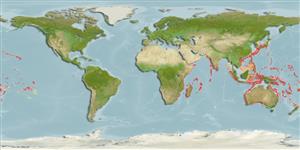Common names from other countries
Environment: milieu / climate zone / depth range / distribution range
ນິເວດວິທະຍາ
ສັດທະເລ ກ່ຽວກັບ(ຢູ່)ຊັ້ນນ້ຳໃນທະເລທີ່ເໜີອພື້ນດິນ; ລະດັບຄວາມເລິກ 150 - 300 m (Ref. 5222). Deep-water; 44°N - 39°S, 29°E - 136°W (Ref. 5222)
Indo-West Pacific: Somalia and South Africa to Japan, Australia and New Zealand. Except for Japan, China, and Korea, most distribution records for Epinephelus septemfasciatus are probably based on this species. Reported as Epinephelus compressus by Postel et al. (Ref. 6453).
ຂະໜາດ / ນ້ຳໜັກ / Age
Maturity: Lm ? range ? - ? cm
Max length : 130 cm TL ຕົວຜູ້/ບໍ່ມີເພດ; (Ref. 4787); ນ້ຳໜັກສູງສຸດທີ່ເຄຍຈັດພີມມາ: 80.0 kg (Ref. 4787); ອາຍຸສູງສຸດທີ່ເຄຍລາຍງານມາ: 43 ປີ (Ref. 92312)
ຄີ (ໜາມ)ແຂງຢູ່ຫຼັງປາ (ທັງໝົດ) : 11; ຄີຫຼັງຂອງປາ (ຄີອ່ອນ) (ທັງໝົດ) : 14 - 15; ຄີ(ໜາມ) ແຂງຢູ່ຄີກົ້ນປາ
ກຸ່ມປາກະດູກແຂງ
ຄວາມຖີ່ຂອງກຸ່ມຖ່າຍທອດພັນ
ປາທີ່ມີການເຄື່ອນຍ້າຍຈາກທະເລໄປຫານ້ຳຈືດ ແລະນ້ຳຈືດຫາທະເລ
ປາທີ່ມີການເຄື່ອນຍ້າຍຈາກທະເລແລະໄປໄຂ່ຢູ່ນ້ຳຈືດ
ຄີກົ້ນຂອງປາ
ສັດທີ່ມີກະດູກສັນຫັຼງ
ການຖ່າຍທອດທາງກຳມະພັນຈາກພໍ່ແມ່ຫາລູກ: 3; ຄີກົ້ນຂອງປາ: 9. Distinguished by the following characteristics: body buff with 8 broad dark brown bars; blackish brown pelvic fins and distal half of the soft dorsal and anal fins; faint dark band from eye to the middle opercle spine; presence of blackish maxillary streak; minute melanophores covering gill rakers and gill arches; depth of body contained 2.2-2.7 times in SL; head length 2.4-2.5 times in SL; distinctly convex interorbital area, convex dorsal head profile; angular preopercle, enlarged serrae at angle; 0-3 small spines at lower edge of preopecle anterior to angle; distinctly serrate lower edge of subopercle and rear edge of interopercle; convex upper edge of operculum; posterior nostrils 2-3 times larger than anterior nostrils; maxilla reaches to below rear half of eye (Ref. 89707).
Probably occurs in rocky reefs. Its apparent rarity may be due to its preference for relatively deep water.
Life cycle and mating behavior
Maturities | ການສືບພັນ | Spawnings | Egg(s) | Fecundities | ຕົວອ່ອນ
Craig, M.T. and P.A. Hastings, 2007. A molecular phylogeny of the groupers of the subfamily Epinephelinae (Serranidae) with revised classification of the epinephelini. Ichthyol. Res. 54:1-17. (Ref. 83414)
IUCN Red List Status (Ref. 130435)
CITES (Ref. 128078)
Not Evaluated
Threat to humans
Reports of ciguatera poisoning (Ref. 30302)
Human uses
ການປະມົງ: ທີ່ເປັນການຄ້າໜ້ອຍ
ເຄື່ອງມື
Special reports
Download XML
ແຫຼ່ງອີນເຕີເນັດ
Estimates based on models
Preferred temperature (Ref.
115969): 13.4 - 21.2, mean 15.7 (based on 136 cells).
Phylogenetic diversity index (Ref.
82804): PD
50 = 0.5001 [Uniqueness, from 0.5 = low to 2.0 = high].
Bayesian length-weight: a=0.01349 (0.00612 - 0.02972), b=3.03 (2.86 - 3.20), in cm Total Length, based on LWR estimates for this Genus-body shape (Ref.
93245).
ຊັ້ນເຂດຮ້ອນ (Ref.
69278): 4.0 ±0.7 se; based on size and trophs of closest relatives
ຄວາມຢືດຢຸ່ນ (Ref.
120179): ຕຳ່ຫຼາຍ, ປະຊາກອນຕຳ່ສຸດທີ່ໃຊ້ເວລາສອງເທົ່າຫຼາຍກວ່າ 14 ປີ (Preliminary K or Fecundity.).
Fishing Vulnerability (Ref.
59153): High to very high vulnerability (68 of 100).
